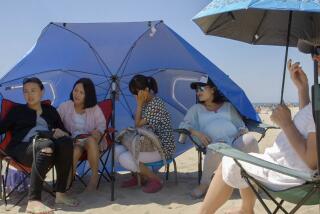Breathing Easy Over Birth Techniques
- Share via
Pregnancy, Birth and the Early Months: A Complete Guide Revised by Richard I. Feinbloom MD and Betty Yetta Forman Ph.D. (Addison-Wesley: $9.95, paper).
“Childbirth in America is in ferment,” announce the authors at the outset of their comprehensive, unusually well-written guide that gets briskly under way by contrasting two different ways of giving birth.
The first, which has been the norm among women in industrialized countries for the past 50 years, is medically managed. “Joan’s” delivery, though it promises to be completely normal, takes place in an operating room; she receives a drug to speed up contractions, a spinal block, and her baby’s progress is watched through electronic fetal monitoring, before the newborn comes into this world with the help of the obstetrician’s forceps.
Conversely, reflecting the desire of many women to control this most natural of experiences, the second delivery takes place at home. “Adrienne” is attended by a midwife, her husband and even friends, who are ushered in as her baby’s head “crowns.” The blessed event is celebrated soon after with food and champagne.
Most women choose a middle course, trying to avoid the use of anesthesia by preparing for labor through breathing and relaxation exercises outlined by Lamaze, Bradley and other proponents of “natural childbirth.” Many hospitals offer alternate birth rooms, sometimes equipped with saunas, so the mother can find the most comfortable position, and fathers, more often than not, are encouraged to take a role in the proceedings.
What the authors do superbly is help couples make informed choices in every area of pregnancy, childbirth and neonatal child care. They’re particularly good in explaining what a Caesarean section entails, citing the astronomically increased numbers of C-sections performed (24% of all births in 1984, and even higher now); they also encourage couples to query their physician on this subject.
Separate chapters cover both amniocentesis and a newer test, the chorionic villous sampling, that gives earlier information about birth defects. Clearly presented information on such topics as genetics, special problems of the older mother and the latest findings on the effects of smoking, alcohol and drugs make this an indispensable guide for all involved in having a baby.






